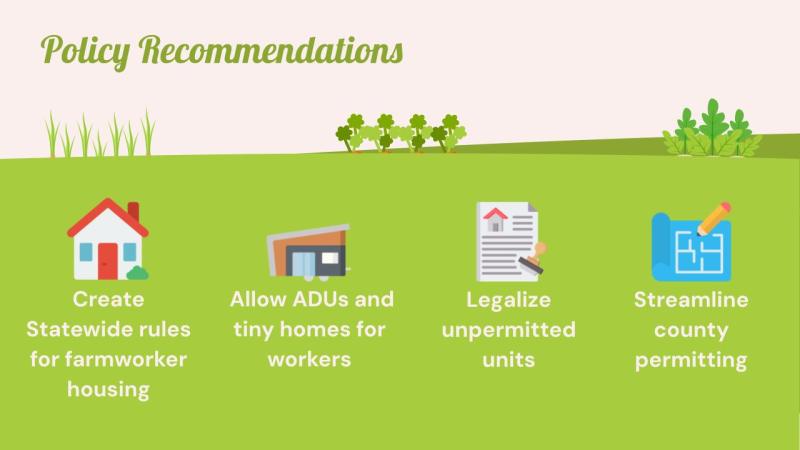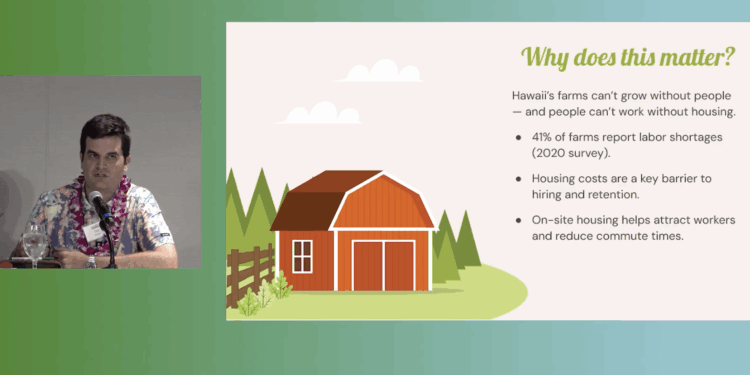The following commentary is based on remarks presented by Ted Kefalas of the Grassroot Institute of Hawaii during an Oct. 15, 2025, housing conference sponsored by Grassroot and the Hawaiʻi Appleseed Center for Law & Economic Justice.
__________
It’s really difficult to be a farmer here in Hawaii, and one of the key issues holding that back is farmworker housing.
Without this, farms can’t grow. Our local food security suffers.
Building housing on land that’s zoned agricultural is extremely difficult given current laws. Farmers face high construction costs, complex land-use rules and long permitting times.
We’ve created a system where doing the right thing is too hard, and it actually results in these farmers doing nothing, or building unpermitted structures, just because that’s the path of least resistance.
This matters because our farms can’t grow without people, and people need housing in order to live and work.
In a 2020 survey, 41% of farms reported facing labor shortages, and a huge portion of that is because of housing costs; they can’t find a place to live.
Looking at the current state law, farm dwellings are allowed in certain instances, but there’s a lack of clear standards.
We define what farm houses are, but we don’t define employee housing, and that small distinction creates big uncertainty.
Counties also have pretty wide discretion, so we end up with a patchwork of rules across the islands, where each county interprets and enforces their laws differently.
Rely more on by-right permitting
One of the big issues is what is allowed to be built by right, which means you don’t have to go through the long permitting process.
On Hawaii Island, you get one per site, essentially. Honolulu allows two farm dwellings total.
On Kauai, you get five farm dwellings, but you also get a guest house per unit — that’s kind of a weird one, where, let’s say, you have a farm, you have three farm dwellings, you’re only allowed three guest homes. If you have five farm dwellings, you can build up to five guest homes, but that’s where the limit kicks in.
And then in Maui County, you get two farm dwellings, and then an additional farmworker dwelling per every five acres.
If you want more than that, you have to go through a discretionary approval process.
To that end, on Hawaii Island, there’s no real limit. As long as you have a farm plan that you submit, and the director approves it, you can get more farmworker housing approved there. And we’ve actually seen, in the past 10 years, 187 approvals.
That’s an example of having clear standards and not a bunch of hoops to jump through.
Honolulu passed a new farmworker housing ordinance this past year that requires a conditional-use permit. We’ve seen zero permits that have been approved so far, but it’s relatively new.
On Kauai, they have some relatively strict rules when it comes to discretionary approvals. It requires a special-use permit, and then additional requirements such as proof of sales and a long-term agricultural tax dedication.
But, when you look at what is allowed by right — the guest houses — over the past year, there’s been 45 applications for guest houses by right.
This goes to show that there’s an appetite for these by-right projects. Once you get to this discretionary point, though, that appetite goes away because people don’t want to wait months or years to get through that process. And it’s very similar on Maui.
Looking back at Honolulu, the county has two agricultural zoning districts: AG-1 and AG-2.
On AG-1, you’re allowed one farm dwelling for every five acres. On AG-2, you get one for every two acres. But no matter the size of your farm — let’s say you have a hundred-acre farm — you are allowed two dwellings total. That’s it.
You can go to the Council and get a special-use permit, but you have to follow all of these rules. So, each dwelling unit can’t be more than 800 square feet. You can have no more than eight dwellings in a multi-unit building.
And, you know, if the farm stops operating, everybody has to move out. And that makes it really difficult. Not having that certainty makes it really difficult for somebody to take on a project like that.
Also, I mentioned there have been no applications since September, when I last looked. So, that tells me that this process is really burdensome for folks.
But, you know, what can we do about it?
Ways to expand farmworker housing
We’re really looking to expand farmworker housing in a practical, responsible way that helps support the people who are really farming these lands and making it possible.

>> So, one thing is to look at a statewide framework for farmworker housing.
Right now, like I mentioned, each county has their own rules, and that inconsistency creates some confusion and delays. Having a framework would help provide clear, consistent standards so farmers can know what’s allowed.
>> We also want to allow more structures such as accessory dwelling units, tiny homes and modular homes for workers.
Farmers need flexibility; not every single type of house is going to work for them. But ADUs and these tiny homes could be huge for seasonal, temporary-type workers.
And by allowing these on farms, we can quickly expand our housing options without necessarily changing the character of our agricultural land.
>> Another option would be to legalize unpermitted units. I talked about it earlier, but there are a lot of unpermitted units out there, and we don’t know how many there are.
Realizing what we have available would be really helpful, and it would help bring these homes into compliance without starting from scratch.
>> And then, finally, streamline county permitting.
I mentioned that on Kauai there were 45 applications for guest houses, which are allowed by right. Only three have been approved this year. And so that is a huge weight for folks that just want to do the right thing.
Moving toward more by-right approvals could help expedite the process.
>> And then I’d be remiss if I didn’t mention the state Land Use Commission.
Currently, the LUC looks at every parcel that’s larger than 15 acres. If you want to turn that parcel from agricultural to residential land, oftentimes you have to go through the LUC. The counties, meanwhile, handle anything under 15 acres.
As a result, we’ve seen that a lot of projects are getting built at 14.9999 acres. And that’s because the LUC has become a situation where, if you’re a homebuilder, you don’t want to go through that. It just adds more uncertainty for you.
So, we need to look at raising that threshold and empowering the counties to do more on their own without having this duplicative review process through the LUC.
Taken together, all of these reforms could really transform the way that we look at our agricultural housing in Hawaii.
More important, they could help strengthen our agricultural industry, support local food production and make it possible for people who work the land to actually live on it.











